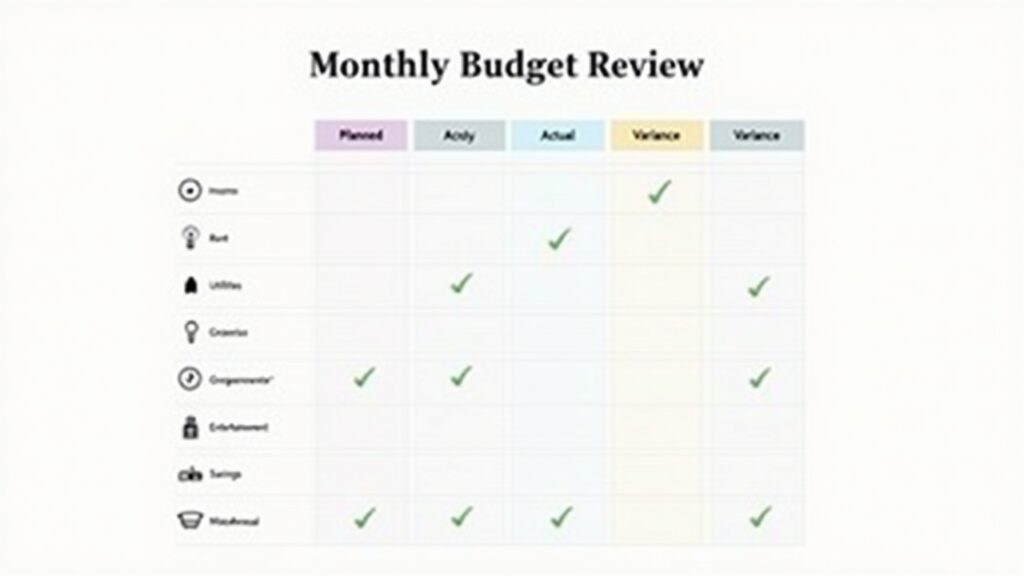Advertisements
Did you know that the average person wastes about $1,200 per year on forgotten subscriptions alone? Yeah, that hit me hard when I discovered I’d been paying for three streaming services I hadn’t used in months!
I’ll never forget the pit in my stomach when I finally sat down to review my budget last year. What started as a simple check-in turned into uncovering over $400 in monthly expenses I’d completely forgotten about. Talk about a wake-up call!
If you’re like me and tend to set your budget and forget it, you’re probably bleeding money without even knowing it. That’s why I’ve put together this budget review checklist – it’s the same one I use every quarter to keep my finances on track.
Before You Dive In: Gather Your Financial Intel

First things first – you can’t review what you can’t see. I learned this the hard way when I tried doing my first budget review with just my memory. Spoiler alert: it was a disaster.
Here’s what you’ll need:
- Last 3 months of bank statements
- Credit card statements (all of ’em!)
- Your current budget spreadsheet or app
- Pay stubs or income records
- Any investment or savings account statements
Pro tip: I like to print everything out and use different colored highlighters. Call me old school, but there’s something about physically marking up papers that helps me spot patterns better than staring at a screen.
The Income Reality Check
Start with the money coming in – it’s usually the easiest part. But don’t just glance at it and move on like I used to do.
Look for these things:
- Has your income changed since your last review?
- Are you counting on overtime or bonuses that might not be guaranteed?
- Did you forget about any side hustle income?
- Are your tax withholdings still accurate?
I once went six months without adjusting my budget after getting a raise. Sounds great, right? Except all that extra money just disappeared into random spending because I never allocated it properly.
Fixed Expenses: The Sneaky Budget Killers
This is where things get interesting. Fixed expenses seem, well, fixed – but they have a way of creeping up on you.
Check these usual suspects:
- Rent/mortgage (including any HOA fees that might’ve increased)
- Insurance premiums (these love to go up without notice)
- Subscription services (the modern money vampire)
- Loan payments
- Utilities (compare to same month last year)
Last month, I discovered my internet bill had somehow jumped from $60 to $85. One phone call and threat to switch providers later, I was back down to $55. Sometimes being a squeaky wheel really does get you the grease!
For a deeper dive into cutting fixed costs, check out NerdWallet’s guide to saving money – they’ve got some solid strategies I’ve actually used.
Variable Expenses: Where the Real Work Happens
Okay, this is where I usually find the most surprises. Variable expenses are tricky because they fluctuate, and it’s easy to lose track.
Key areas to scrutinize:
- Groceries (are you really sticking to that meal plan?)
- Dining out and takeout
- Gas and transportation
- Entertainment and hobbies
- Personal care and clothing
True confession: I once discovered I was spending $300 a month on coffee shops. THREE HUNDRED DOLLARS! That was more than my car payment at the time.
Now I use the Mint app to track these expenses in real-time. It sends me passive-aggressive notifications when I’m overspending in a category, which honestly works better than my own willpower.
The Forgotten Categories
These are the expenses that’ll sneak up and bite you if you’re not careful. I call them “budget ninjas” because they hide in the shadows.
- Annual fees (membership renewals, professional licenses)
- Irregular maintenance (car service, home repairs)
- Gifts and celebrations
- Medical expenses not covered by insurance
- Pet care (vet visits always cost more than expected!)
Setting up sinking funds for these changed my financial life. Instead of scrambling when my car needs new tires, I’ve got money set aside. It’s like past-me is looking out for future-me.
Your Savings and Debt Game Plan
This part used to depress me, but now it’s actually motivating. Seeing progress, even small progress, keeps me going.
Review these areas:
- Emergency fund status (aim for 3-6 months of expenses)
- Retirement contributions (are you maxing out employer matches?)
- Debt paydown progress
- Short-term savings goals
If you’re struggling with debt payoff strategies, Dave Ramsey’s comparison of snowball vs avalanche methods really helped me figure out what worked for my psychology.
Time to Take Action

Alright, you’ve done the review – now what? Don’t let all this work go to waste!
The most important thing is to actually make changes based on what you found. I keep a simple action list with three categories: Stop, Start, and Adjust. Maybe you need to stop that unused gym membership, start automating your savings, or adjust your grocery budget to match reality.
Remember, budgeting isn’t about perfection – it’s about progress. Every time I review my budget, I find something that needs tweaking. That’s not failure; that’s just life happening.
The key is making this a regular habit. Put it in your calendar, set a reminder, whatever it takes. Your future self will thank you when you’re not scrambling to figure out where all your money went.
Ready to level up your money game even more? Head over to Cashflow Zen for more practical tips on mastering your finances. Trust me, your wallet will thank you!




[…] more tips on taking control of your finances? Check out other helpful articles at Cashflow Zen – we’re all about making money management less stressful and more, well, […]